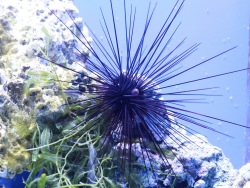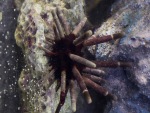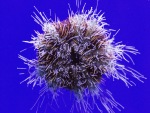Such different urchins

New residents have been added to the Small Coral Reef – when exploring the fish tanks of the exhibit, you can meet several species of tropical sea urchins that look completely different from each other.
Snowflake morays, soldierfishes and squirrelfishes share their habitat with pencil sea urchins (Eucidaris tribuloides). This echinoid, found in warm seas along the Atlantic coast of America, gets its common name from thick spines resembling pencils. The spines enlarge the animal’s size severalfold – while the diameter of the sea urchin test is only 4 cm, the overall diameter, including spines, can be up to 18-20 cm.
Long-spined sea urchins (Diadema setosum) have become tank mates to razorfish. In the wild these small fish, which usually swim with their head down, often find shelter among the long spines of Diadema urchins to escape predators. The size of the test in this urchin species does not exceed 7 cm but its spines can grow up to 50 cm in length, and there are short spines hidden under the long ones.
Another newcomer to the exhibit is the pincushion tuxedo urchin (Mespilia globulus). The species’ common name derives from the urchin's appearance - vertical naked areas of the test with a velvet texture are deep blue, olive green or black and alternate with zones densely covered with short thin spines that come in various shades of red and brown. The pincushion tuxedo urchin is known for its preferred method of camouflaging itself – the animal attaches small rocks and algae to its body and gets nearly invisible, concealed under such “décor”.

